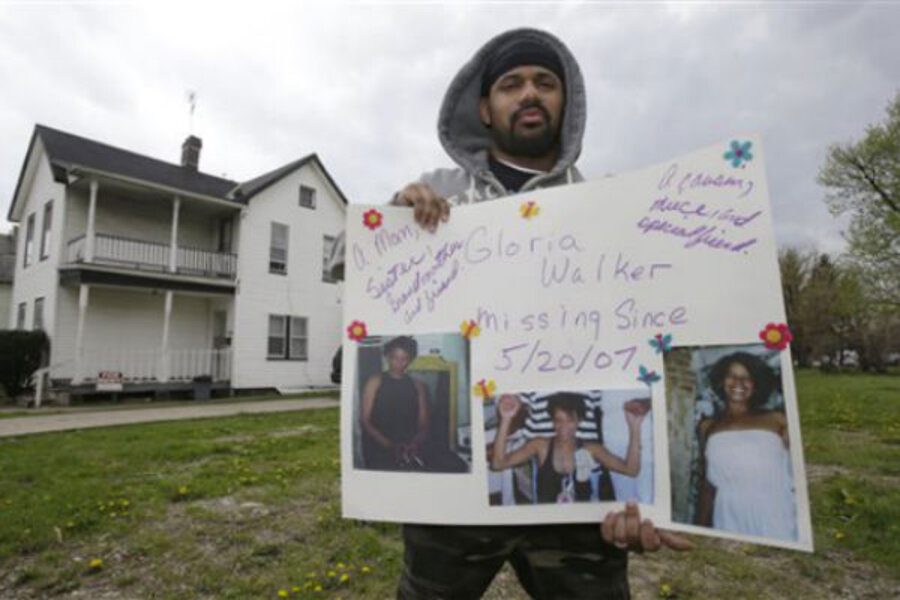One year after missing women freed, other families await answers
Loading...
| CLEVELAND
The house fortified with boarded-up windows and makeshift alarms where Ariel Castro held three women captive for nearly a decade is gone now.
So are the missing-persons posters that were taped to light poles and restaurant windows throughout a neighborhood haunted by the disappearances of so many girls over the years.
What hasn't changed since the stunning discovery of those three women is that others are still missing from those same streets.
For those families given a glimmer of hope by the women's escape, the past year has been filled with new leads, fruitless searches and, for one, a heartbreaking end.
"I can't say we're jealous, but we're disappointed we don't have that resolution," said Greg Washington, a close friend of a woman who disappeared in 2007. "We just want resolution. Either have her back or know what happened."
Optimism soared during the chaotic hours after Amanda Berry broke through a screen door to freedom last May. Upstairs, officers found Gina DeJesus and Michelle Knight. They had been snatched off the streets separately from 2002 to 2004 and locked inside Castro's house, investigators later said
Two miles away, Albert Kleckner stared at his television in disbelief. "I was hoping my daughter would come out next," he said.
A few families showed up at the hospital where the three women were being evaluated. Too overwhelmed to drive, a neighbor took Tonia Adkins to see if her big sister, Christina, who disappeared in 1995, had been found.
"There was such high hope, and all of a sudden, it was taken away again," Adkins said.
Finding the three kidnapped women generated new tips about 18-year-old Christina Adkins and a 14-year-old girl who disappeared years ago in the same area. Investigators also looked into whether Castro was tied to other disappearances but found nothing.
Families of the missing held rallies during the summer and joined police officers to pass out fliers, hoping for their own miracle. "It has brought a sense of unity and urgency," said Angel Arroyo, a pastor who has worked with families in Cleveland.
Arroyo and Gina DeJesus' father went to door-to-door last summer after a young woman disappeared in a neighboring city. Felix DeJesus also joined relatives of another missing woman at rally in June to make sure she wasn't forgotten either.
"People deep down didn't believe, but he didn't give up hope," said Manuel Walker, whose mother, Gloria Walker, was last seen on the city's east side seven years ago. "For him to find his daughter, it gives you hope, more than you already had."
The list of missing people in Cleveland, a city of just under 400,000, makes up about one out of every 10 unresolved cases in the entire state. Cleveland police records show nearly 2,800 missing persons cases last year alone.
Most are found within a few days or weeks, but 23 people have been gone for more than a year, some since the early 1990s.
Christina Kleckner was 24 when she left home after an argument more than two years ago and hasn't been seen since.
Her father, Albert, hasn't stopped looking. When he's driving through the neighborhood, he takes a different way home each time, hoping he might see her in a passing car or on a porch.
He has stacks of fliers that he puts up on street corners but often finds them buried under ads for cheap loans and mattresses. Store owners tell him they can only keep his signs up for two weeks.
"The other places, they just take them down," he said.
His daughter is developmentally disabled and unable to take care of herself.
"Somebody's got her," he said. "Whether it's against her will or voluntarily, we don't know."
Often times, those who go missing are runaways or have lost touch with their families.
Five years ago, Cleveland police were heavily criticized following the discovery of 11 women's bodies in the home and backyard of a man later convicted and sentenced to death.
Police have since changed how they handle missing-persons cases, but activists like Arroyo think authorities need to be more proactive when people go missing. He has met with lawmakers to discuss an idea for issuing notifications when a child is missing or has run away but doesn't meet all the criteria for an Amber Alert.
Detectives believed Christina Adkins was a runaway when she disappeared in 1995. She was five months pregnant and had fought with her boyfriend. Family members said they had little contact with investigators until 2009, when the FBI and police reached out to them.
But it wasn't until the three women were freed from Castro's home that they finally got a break in the case.
"People had forgotten about my sister," Tonia Adkins said. "The finding of the three girls finally woke people up. They said, 'Something's not right.'"
New leads came within days. In August, less than a week before Castro committed suicide in prison, FBI agents searched a house about five blocks from where Castro had lived. About a month later, they looked through an overgrown park and then along a freeway.
They found her remains in a manhole after a convicted sex offender confessed and led detectives to the site. Elias Acevedo, who lived a few houses away from Castro, pleaded guilty to killing Christina Adkins and another woman last December and is serving a life sentence.
Tonia Adkins says finding out what happened to her sister has lifted the guilt and anxiety she has felt over the last two decades.
"I spent 18 years blaming myself," she said. "My parents spent 18 years blaming themselves. We now know there's nothing we could have done differently."







